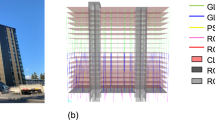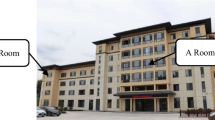Abstract
This study investigates the vibration characteristics of composite timber-concrete floor systems to provide a reliable benchmark for optimizing composite floor system designs. This paper uses the numerical and analytical methods for evaluation to support more detailed study results and to build a comprehensive model for future research. Through Strand7 and ABAQUS numerical finite element analysis, geometrical layout and beam material effects on the timber-concrete composite floor are thoroughly explored. Meanwhile, the analytical results are further compared with the analytical solution based on the Dunkerley method and AISC. Then 15 kinds of timber-concrete composite floor designs are simulated and numerically tested. It was found that the dimensions of the timber beams and their composition might affect the natural frequencies of the floors. On this basis, this paper proposes future design schemes to provide reliable suggestions for further research.
You have full access to this open access chapter, Download chapter PDF
Similar content being viewed by others
Keywords
1 Introduction
The wood laminate flooring is a cost-effective structural solution that combines wood beams with concrete slabs and easily meets strength and deflection standards. The composite timber concrete floor technology may offer longer span floors with shorter sections and higher stiffness [1]. Wood is a renewable resource in Australia, reducing the use of steel in construction. Therefore, high-rise buildings can optimize material consumption. Human kinetic motion causes floor vibration, resulting in occupant discomfort and structural damage [2]. Living load affects the design of lighter, longer composite flooring, especially under ultra-low vibration settings. Although numerous studies have focused on the natural frequencies of composite floor systems, they are not reliable benchmarks for optimizing the structural design of wood-concrete composite floor systems (floor system geometry layout, beam dimension, slab thickness and timber material selection). To improve the structural safety design, it is necessary to analyze the vibration characteristics of wood-concrete composite floor system. To control composite floor serviceability and understand its changeable behaviour, simulations are run using finite element analysis with an analytical solution to simulate the floor's natural frequency. This paper examines a pin-supported timber-concrete floor, and the natural frequency of composite floor slab is discussed by numerical analysis and analytical method. On this basis, Strand7 and ABAQUS software are used to study the geometric arrangement of wood-concrete composite floor and the influence of beam materials. The findings are compared to Dunkerley and AISC [3].
Modeling strategies include simulating the natural frequencies of a wood-concrete composite floor system. The natural frequencies are calculated according to the design specifications, the numerical and analytical solutions of Strand7 and ABAQUS are compared, and some suggestions are made for the arrangement of composite floors and material sections. Strand7 and ABAQUS are used to model numerical solutions. The beam components simplify main and secondary beams in Strand7, and the slab is a shell element. The connections are at common nodes only. ABAQUS employs solid elements to replicate beam and slab elements, and element interaction may be simulated. Strand7 is supposed to provide more precise solutions than ABAQUS.
2 Model Stargey
2.1 Model
This paper uses a composite floor model to study the self-weight vibration response of wood-concrete floor system. The model is 4 × 3.2 m. The concrete slab was supported by 160 mm × 200 mm beams, and the calculation is aided by rigid connections. Simulating and analysing Strand7 and ABAQUS models are early steps. Strand7 employs beam and shell components for main and subsidiary beams, and the standard nodes use support connections. ABAQUS uses solid pieces with tie connections to depict beams and slabs.
2.2 Material
AS3600-1994 [3] requires f'c = 32 mpa concrete for slabs. According to the Queensland Business Report, Radiata pine, Jarrah and redwood are the most widely used commercial timber resources in Australian construction [4]. The following tables illustrate composite floor geometry.
2.3 ABAQUS Modeling Approach Explanation
The full structure is discretized using a 40 mm 40 mm 40 mm mesh, and each neighbouring element is linked to reduce computational error. For the connection between the primary and secondary beams and the concrete slab, a tie rod connection model is used, with both solid and uniform sections, and a four-pin supporting boundary is established. Tables 1 and 2 provide characteristics. To analyse the composite floor's natural frequencies, a Lanczos eigen solver is utilised.
2.4 STRAND7 Modeling Approach Explanation
Floor slab and beam are modelled using Strand7’s Quad8 plate and Beam2 parts. The section of the beam is as described. Strand7 connected the slab and beam with common nodes, causing the slab to rest on the beam's mid-flange. To reduce the impact, beam components were offset by 0.01 m. Simulated edge pin connections prevent edge movement. Strand7's natural frequency solver determines the composite floor's fundamental frequency and vibrational response. Tables 1 and 2 provide characteristics, and the simulated model is as shown in Fig. 1.
3 Analytical Solution to Calculate Fundamental Frequency
According to the recommendation of Hicks [5], the governing equation to calculate the natural frequency of free elastic beam or uniform section vibration can be derived under bending.
where:
EI = Dynamic flexural rigidity of the member
m = Distributed mass
L = member span
kn = Coefficients of beam support. For the simply support element under distributed load, kn = π2
The maximum displacement equation for simply supported beam is:
where, g is the acceleration of gravity, 9.81 m/s2.
Thus, rearranging the above Eq. (2) and (3), the natural frequency of individual members can be determined under maximum displacement.
Moreover, according to the Design Guide 11 by AISC [3], which shows the equation of the natural frequency of a simply supported beam under UDL.
where:
fn = Natural frequency
g = Gravitational acceleration (9.81 m/s2)
Et = Modulus of elasticity of steel
It = The moment of inertia
ω = Uniform weight per unit length
L = Member span.
3.1 Boundary Condition
The condition of pin support is applied to the primary beam and the fixed support is used for the secondary beam and concrete slab. The main beams are locked in translation and free rotation, while the sub-beams and concrete slabs are locked in translation and rotation, taking into account the effects of the primary and secondary moment zones.
4 Numerical and Analytical Results Analysation
The first 15 models were simulated using ABAQUS and Strand7 and compared with the analytical solutions. The effect of timber-concrete composite floor geometry layout and beam material on the natural frequency are investigated.
4.1 Primary Beam Length Effect
Table 3 and Fig. 3 show the natural frequencies of models with different girder lengths. Strand7 and ABAQUS experiments show fundamental frequencies drop with primary beam length. The same trend is found in the analysis method, and the results are in good agreement with ABAQUS (Fig. 2).
4.2 Secondary Beam Length Effect
Table 4 shows the natural frequencies of models with different sub-beam lengths, and Fig. 4 provides the numerical and analytical results. Both Strand7 and ABAQUS fundamental frequencies diminish as secondary beam length increases. The analytical solution is more accurate than Strand7 because the findings are more like ABAQUS.
4.3 Number of Bays Effect
Table 5 shows natural frequencies for models with different bay counts. Both Strand7 and ABAQUS tests found that the fundamental frequency rose somewhat as the number of bays increased, but the analytical results remained consistent.
4.4 Concrete Slab Thickness Effect
Table 6 provides natural frequencies for models with different slab thicknesses. The results of Strand7 and ABAQUS show that the slab depth has little effect on the fundamental frequency. Even if ignoring the change, the analytical solution shows the same trend.
5 Error Analysing
Despite the offset function, Strand7 has computational issues since the node can only build the beam and plate, resulting in a lack of slab-to-beam connections when simulating models. The analytical solution ignores the connection of plate and beam, leading to the discovery of error. In the simulation, the boundary condition is pin support. However, the performance of the floor is affected by the connections between the floor and the beams.
6 Conclusion
This paper uses STRAND7 and ABAQUS to determine the natural frequencies of wood composite flooring. Analytical solutions based on Dunkerley and AISC are simulated to confirm finite element model results accuracy.
The longer the beam, the lower the base frequency of the floor system. Number of bays affects flooring frequency, although less than beam length. As the compartment expands, the frequency of the composite floor increases, and the thicker concrete slab increases the fundamental frequency. Beam composition affects results. The E/m term influences the rise or decrease of the floor's fundamental frequency, so a material with a higher E/m term may raise the frequency.
The span of the beams has the largest impact on the fundamental frequency of a wood composite floor. Consequently, it should be carefully adjusted to minimize resonance with human activity. Pine beams are recommended.
Regarding the dynamic behaviour of the composite floor, a force-induced vibration test is recommended since most harmful vibrations are created by subject forces.
References
Du H, Hu X, Xie Z, Wang H (2019) Study on shear behavior of inclined cross lag screws for glulam-concrete composite beams. Constr Build Mater 224:132–143
Feldmann M, Heinemeyer C, Butz C, Caetano E, Cunha A, Galanti F, Goldack A, Hechler O, Hicks S, Keil A et al (2009) Design of floor structures for human induced vibrations. EUR: Luxembourg
Lenzen KH (1966) Vibration of steel joist-concrete slab floors. AISC Eng. J. 3:133–136
Rijal R, Samali B, Shrestha R, Crews K (2015) Experimental and analytical study on dynamic performance of timber-concrete composite beams. Build Mater 75:46–53
Hicks S (2004) Vibration characteristics of steel-concrete composite floor systems. Prog Struct Eng Mater 6:21–38
Author information
Authors and Affiliations
Corresponding author
Editor information
Editors and Affiliations
Rights and permissions
Open Access This chapter is licensed under the terms of the Creative Commons Attribution 4.0 International License (http://creativecommons.org/licenses/by/4.0/), which permits use, sharing, adaptation, distribution and reproduction in any medium or format, as long as you give appropriate credit to the original author(s) and the source, provide a link to the Creative Commons license and indicate if changes were made.
The images or other third party material in this chapter are included in the chapter's Creative Commons license, unless indicated otherwise in a credit line to the material. If material is not included in the chapter's Creative Commons license and your intended use is not permitted by statutory regulation or exceeds the permitted use, you will need to obtain permission directly from the copyright holder.
Copyright information
© 2023 This is a U.S. government work and not under copyright protection in the U.S.; foreign copyright protection may apply
About this chapter
Cite this chapter
Liu, M. (2023). Analytical and Numerical Analysis for the Vibrational Response of Timber-Concrete Composite Floor. In: Yang, Y. (eds) Advances in Frontier Research on Engineering Structures. Lecture Notes in Civil Engineering, vol 286. Springer, Singapore. https://doi.org/10.1007/978-981-19-8657-4_1
Download citation
DOI: https://doi.org/10.1007/978-981-19-8657-4_1
Published:
Publisher Name: Springer, Singapore
Print ISBN: 978-981-19-8656-7
Online ISBN: 978-981-19-8657-4
eBook Packages: EngineeringEngineering (R0)







